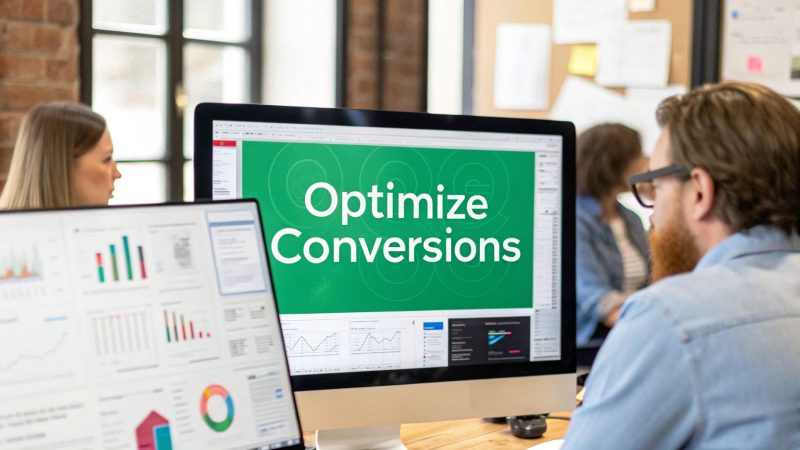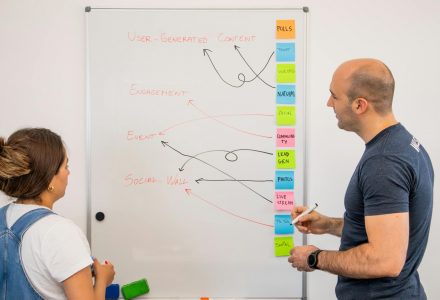Mastering Conversion Optimization Fundamentals That Actually Work
Let’s explore the core principles behind a successful conversion optimization strategy. Instead of getting bogged down in theory, we’ll dive into practical tactics that turn website visitors into paying customers. These insights come directly from CRO specialists who’ve generated millions in additional revenue. Understanding user psychology is key.
It’s about going beyond simply attracting visitors and focusing on what motivates them to act.
The Power of Psychology in Conversion Optimization
Successful brands don’t rely on guesswork; they analyze. By combining behavioral analysis with strategic testing, they build sustainable growth. This helps them understand not only what users are doing, but also why. Many businesses get sidetracked by vanity metrics.
Instead of chasing likes and shares, prioritize the user journey and identify friction points.
You might be interested in: How to master website conversion rates
Optimizing for Impact, Not Overhaul
Small, strategic optimizations often yield better results than complete website redesigns. These targeted changes can significantly impact key conversion points. Finding these high-impact opportunities is essential for effective conversion optimization. Mastering this requires a deep understanding of effective tactics.
Explore practical tips with these conversion optimization tips to focus your efforts for maximum return.
Benchmarking Your Conversion Performance
Conversion rate optimization (CRO) statistics provide valuable benchmarks. The average eCommerce conversion rate is around 2.96%, according to Content Square’s 2025 Digital Experience Benchmark Report. This is higher than the cross-industry average of 2.3%, highlighting the competitive landscape and optimization potential within eCommerce. More detailed statistics can be found here.
This data provides context for your own conversion rates and reveals areas for improvement within your industry. Knowing where you stand relative to industry averages helps set realistic goals and develop a stronger conversion optimization strategy. A strong foundation in these fundamentals is essential for long-term success.
Technical Conversion Killers Most Businesses Never Address
Beyond beautiful design and compelling copy lies a critical, often overlooked, aspect of conversion optimization: technical performance. These hidden factors can significantly impact your website’s ability to convert visitors into customers. Even experienced marketers sometimes miss these crucial elements.
The Impact of Slow Loading Times
One of the most common technical issues impacting conversions is slow loading speed. Think of your website as a brick-and-mortar store. If customers have to wait an excessive amount of time to enter, they’re likely to go elsewhere. This is especially true in the fast-paced online world.
Website performance has a direct correlation with conversion rates. Studies show that for every additional second it takes a page to load, conversion rates can drop by approximately 0.3%. Pages loading in about 1 second can see conversion rates near 40%. However, this number can plummet to 20% when load times reach 5 seconds.
To better illustrate this impact, let’s look at a table showcasing the relationship between page load times and conversion rates:
Page Load Time Impact on Conversion Rates
This table illustrates the direct relationship between page load times and conversion rate percentages, showing how performance optimization directly affects business outcomes.
| Page Load Time (seconds) | Average Conversion Rate (%) | Conversion Rate Drop (%) |
|---|---|---|
| 1 | 40 | 0 |
| 2 | 39.7 | 0.3 |
| 3 | 39.4 | 0.6 |
| 4 | 39.1 | 0.9 |
| 5 | 20 | 20 |
As you can see, even small increases in load time can have a noticeable impact on conversions. By the time a page reaches 5 seconds, the drop becomes substantial, emphasizing the need for speed optimization. For more detailed statistics on this relationship, you can check out this resource: Conversion Rate Optimization Statistics.
Mobile Optimization: A Critical Conversion Factor
Another significant technical hurdle is poor mobile experience. With the vast majority of internet traffic originating from mobile devices, a mobile-responsive site is no longer a luxury—it’s a necessity. A negative mobile experience can result in frustrated users and a loss of potential sales.
Imagine a user trying to navigate your site on their phone. If it’s difficult to use, they’re unlikely to complete a purchase. Responsive design, which ensures your website adapts to different screen sizes, is essential. Failing to prioritize mobile optimization means potentially losing a large segment of your target audience.
Identifying and Addressing Technical Roadblocks
Top-performing brands understand the critical nature of addressing technical issues. They actively seek out and resolve these problems, often realizing substantial conversion gains with minimal design alterations. This proactive approach shows a dedication to a seamless user experience.
For more insights on eCommerce conversion optimization, take a look at this article: Your Guide to eCommerce Conversion Rate Optimization
Prioritizing Technical Fixes for Maximum Impact
Prioritizing technical fixes requires a strategic approach. Focus on the potential revenue impact, not just the ease of implementation. Simple fixes might offer minimal conversion improvements, while more complex issues could be significantly impacting your revenue.
A data-driven approach is essential for pinpointing the most impactful areas for improvement. By targeting the technical issues with the greatest potential to affect your bottom line, you can maximize your return on investment and drive sustainable growth. This ensures your efforts are concentrated where they’ll have the biggest impact. A truly effective conversion strategy considers both the visible and the unseen elements of user experience.
Industry-Specific Strategies That Transform Conversion Rates
Generic conversion advice often misses the mark. What works for one business might not work for another. Each industry faces its own unique challenges. Understanding these nuances is key for effective conversion rate optimization (CRO).
Why One-Size-Fits-All CRO Fails
Consider this analogy: a fishing lure designed for bass won’t necessarily attract trout. In the same way, a conversion tactic that boosts sales for an eCommerce store might not be effective for a B2B SaaS company. User behavior, motivations, and decision-making processes all vary across industries.
An eCommerce store might leverage impulse buys with flash sales and prominent “add to cart” buttons. However, a B2B SaaS company selling complex software solutions needs a different approach. They should focus on building trust, providing detailed information, and nurturing leads. Applying the same CRO strategy across the board simply won’t work.
B2B Conversion Optimization: Building Trust and Relationships
B2B conversions are often driven by relationships and demonstrated value. This means providing in-depth content like case studies and testimonials. These build credibility and address concerns. Personalized communication and targeted outreach are also effective in fostering trust and moving leads through the sales pipeline.
Industry-specific CRO is particularly important in B2B eCommerce and SaaS. B2B eCommerce often sees a lower average conversion rate, around 1.8%. This is due to higher transaction values and more cautious buyer journeys. B2B buyers need more nurturing, personalized content, and trust-building—factors that differ significantly from B2C. Learn more about B2B conversion optimization here.
eCommerce Conversion Optimization: Streamlining the Purchase Process
eCommerce thrives on a smooth purchase journey. This means making the process as frictionless as possible, from product discovery to checkout. Clear product descriptions, high-quality images, and user-friendly navigation are vital for converting browsers into buyers. Tactics like abandoned cart emails and personalized product recommendations can also encourage purchases and increase average order value.
SaaS Conversion Optimization: Demonstrating Value and Driving Trials
For SaaS companies, the primary goal is often driving free trials or demos. This requires clear communication of the software’s value proposition. Showcasing benefits through compelling visuals and concise messaging is also crucial. Optimizing the onboarding process and providing excellent customer support can then convert trial users into paying subscribers.
Tailoring Your Strategy to Your Industry
The key takeaway? Your CRO strategy must be tailored to your industry and audience. Understanding the unique motivations and decision-making processes of your customers is essential. By focusing on the factors that resonate most strongly with your target market, you can improve your conversion rates and drive significant business growth.
This requires a thorough analysis of your target audience, their needs, and their behavior within your industry. Consider the length of the sales cycle, the product or service complexity, and the level of customer involvement needed to make a purchase. By aligning your CRO strategy with these industry-specific factors, you create a more effective approach.
Building a Testing Framework That Delivers Consistent Wins
A robust conversion optimization strategy requires more than just occasional adjustments. It demands a systematic testing framework designed to produce meaningful and repeatable results. This means shifting away from making random changes and embracing a data-driven approach.
Developing a Hypothesis-Driven Testing Program
Truly successful companies don’t just test randomly. They develop hypothesis-driven testing programs that directly connect insights with potential revenue growth. Think of it like a scientific experiment: you begin with a hypothesis about what might improve conversions, then rigorously test it.
This involves clearly defining your objectives, identifying key performance indicators (KPIs), and designing tests to specifically address your hypotheses. This structured approach yields more valuable insights for optimization.
Prioritizing Tests Based on Impact
Not every test carries the same weight. Some have a bigger impact on your profits than others. Prioritize tests based on their potential to improve revenue, not just on ease of implementation.
Optimizing a high-traffic landing page, for example, might have a greater impact on conversions than tweaking a less-visited page. Focusing on high-impact areas ensures the most efficient use of your resources.
Avoiding Statistical Pitfalls in Testing
Testing requires a solid understanding of statistics to avoid misleading conclusions. It’s vital to ensure your tests reach statistical significance before implementing changes. This helps determine if observed results are actually due to modifications or just random chance.
You might be interested in: How to master conversion rate optimization tools
Creating a Culture of Experimentation
Team buy-in is essential for a thriving testing program. Cultivate a culture of experimentation where testing is viewed as an opportunity for continuous improvement, not an extra task.
This means communicating the benefits of testing, involving team members in the process, and celebrating successes. When initial hesitation transforms into enthusiastic participation, your organization’s approach to growth is revolutionized.
Documenting Tests and Building Organizational Knowledge
Thorough documentation is the key to creating a robust knowledge base. Document each test’s process, results, and conclusions to learn from both successes and failures.
Consider this documentation as your evolving playbook for conversion optimization. It prevents repeating past mistakes and allows you to build on previous wins, strengthening your overall strategy over time.
Scaling Your Testing Program for Growth
As your business expands, your testing program should too. Implementing frameworks for concurrent experiments prevents contamination of results. Running multiple tests simultaneously accelerates optimization, but careful design is critical to avoid interference.
This requires a structured approach to design and analysis, ensuring that changes in one area don’t unintentionally impact others. As your program matures, shift focus from isolated tests to a holistic optimization strategy, considering the entire customer journey.
Personalization Strategies That Dramatically Lift Conversions
The infographic above illustrates how a robust conversion optimization strategy impacts three core metrics: Conversion Rate, Bounce Rate, and Average Session Duration. The data reveals impressive gains. Conversion rates doubled, bounce rates plummeted, and average session duration saw a significant boost. This indicates more engaged users, which ultimately leads to increased revenue. But what’s the secret? Effective personalization.
Understanding the Power of Personalization
Personalization goes beyond simple segmentation. It involves creating unique, individual experiences tailored to each user. This includes customizing website content, providing targeted product recommendations, and even sending personalized email communications. For instance, an eCommerce store might suggest items based on a customer’s past purchases and browsing behavior.
Implementing Effective Personalization Techniques
Businesses have a broad spectrum of personalization tactics at their disposal. Each tactic comes with its own set of complexities and resource demands. It’s vital for businesses to select strategies that align with their current resources and objectives. A new startup might start with personalized email greetings, while a larger company could utilize dynamic content that adjusts in real time to user activity.
To further illustrate the variety of techniques, let’s look at a comparison table:
To help you choose the right approach for your business, we’ve compiled a comparison of different personalization techniques. This table breaks down the complexity, resources, and potential benefits of each approach.
Personalization Techniques Comparison
| Personalization Technique | Implementation Complexity | Resource Requirements | Average Conversion Lift | Best For |
|---|---|---|---|---|
| Personalized Email Greetings | Low | Low | 1-5% | Startups, Small Businesses |
| Segmented Email Campaigns | Medium | Medium | 5-15% | Growing Businesses |
| Dynamic Website Content | High | High | 10-25% | Large Enterprises |
| Product Recommendations | Medium | Medium | 5-20% | E-commerce Businesses |
| Personalized On-site Offers | Medium | Medium | 10-25% | Businesses with promotions |
Key takeaways from this table include the potential for significant conversion increases with more sophisticated techniques and the importance of choosing a strategy that aligns with your available resources. Start small, test different approaches, and gradually scale up your personalization efforts.
Balancing Personalization and Privacy
While personalization holds immense potential, responsible data handling is paramount. Transparency is crucial. Openly communicate your data collection practices to users and ensure compliance with relevant privacy regulations like GDPR. This builds trust and strengthens customer relationships.
Measuring the Impact of Personalization
Accurately measuring the results of your personalization strategy is essential. This involves looking beyond simple conversion rates. Consider metrics like customer lifetime value and long-term engagement for a holistic understanding of your ROI. These metrics offer a more complete picture of your personalization program’s success.
By implementing these strategies, businesses can craft more engaging, relevant experiences that resonate with their audience, driving substantial increases in conversions and promoting overall growth.
Journey-Based Optimization That Guides Visitors to Conversion
A truly effective conversion rate optimization (CRO) strategy recognizes that the customer journey isn’t a single event, but a process. Each stage of this journey requires a distinct approach. To optimize for conversions, understanding the psychological shifts prospects experience as they move from initial awareness to final purchase is crucial.
Mapping the Customer Journey for Conversion
Think of the customer journey as climbing a mountain. Each step offers a new perspective and demands different gear. At the base, you’re focused on the broad view, the summit. As you ascend, your attention narrows to the immediate challenges, the next handhold.
Similarly, a potential customer begins with a general need or problem. They then progress through stages of research, evaluation, and finally, the decision to purchase. Each stage requires different information and levels of engagement. Initially, they need broad information about potential solutions. As they move forward, they look for specific details and comparisons to make an informed choice.
Identifying Friction Points and Barriers
Friction points are those moments in the customer journey where prospects encounter obstacles. These obstacles can range from a confusing website layout to a complicated checkout process.
Imagine climbing that mountain in worn-out boots. It makes the journey arduous and increases the chances of turning back. A poorly designed website, slow loading times, or unclear calls to action (CTAs) can similarly discourage potential customers, leading to abandoned carts and lost leads.
Targeted Optimizations for Each Stage
After pinpointing the friction points in each stage of the sales funnel, you can develop targeted optimizations. This is where a conversion optimization strategy takes shape.
For instance, addressing friction in the decision stage might involve simplifying the checkout process. Offering multiple payment options and providing live chat support for immediate answers can also make a difference. This personalized approach improves the user experience and boosts conversions. Companies are implementing multi-step checkouts, personalized pricing, and live chat support, which have been shown to enhance engagement and conversions. For example, EcoFoil, a US-based insulation supplier, increased purchases by 86% using these targeted optimizations. SaaS companies also demonstrate higher conversion averages, with a 9.5% average conversion rate and a 2.4% form fill rate, according to Unbounce. More detailed statistics can be found here.
Creating Cohesive Cross-Channel Experiences
A successful conversion optimization strategy goes beyond a single channel. It creates a seamless experience across all touchpoints, from social media and email marketing to the website itself.
Think of each channel as a different trail leading up the same mountain. Each trail offers a unique view, but they all ultimately lead to the same summit. Consistent messaging and user experience across all channels reinforce your brand and maintain prospect engagement throughout their journey.
Stage-Appropriate Messaging and Engagement
Your language and tone should also adapt as prospects move through the customer journey. Initially, concentrate on building awareness and educating your audience. As they approach a decision, provide more specific information and address their concerns directly.
In the mountain-climbing analogy, this is similar to adjusting your pace and strategy as you ascend. You can take a more relaxed approach at lower altitudes. As you climb higher, however, each step demands more careful planning and execution.
Progressive Engagement Tactics
Guiding prospects towards conversion should feel natural. Implementing progressive engagement tactics, like personalized email sequences or targeted website pop-ups, can nurture leads and gently encourage the next step.
This is like providing strategically placed rest stops and signposts along the mountain trail. These offer encouragement and guidance without being intrusive. By anticipating your prospects’ needs at each stage, you create a more engaging and successful customer journey. This translates to more conversions and better business results.
Beyond Surface Metrics: Measuring What Actually Matters
Focusing solely on conversion rates can be misleading. While conversion rates are important, this single metric doesn’t provide a complete picture of your marketing effectiveness. To truly understand the impact of your conversion optimization strategy, you need to delve deeper. Successful businesses analyze a broader range of data beyond basic conversion numbers.
Measuring Visitor Quality and Customer Lifetime Value
Not all conversions are created equal. A high conversion rate doesn’t automatically translate to high profits. It’s essential to consider visitor quality. Are the converting visitors likely to become repeat customers? What is their potential customer lifetime value (CLTV)? Analyzing CLTV offers a more nuanced understanding of your optimization efforts’ true impact on your bottom line.
For example, imagine two campaigns with identical conversion rates. Campaign A attracts visitors who make a single, small purchase. Campaign B, however, attracts visitors who become loyal, making multiple purchases over an extended period. Campaign B is clearly more valuable in the long run, despite the initially identical conversion rate.
Attributing Conversions in a Multi-Touch World
Customer journeys are rarely linear. People frequently interact with your brand across multiple touchpoints before finally converting. Accurately attributing conversions within this complex landscape can be challenging. Implementing robust tracking systems and analytics, like B2B customer journey mapping, helps you understand which channels and campaigns are truly the most effective. Knowing how visitors navigate your site allows you to identify and optimize key touchpoints.
Consider a customer who discovers your product through a social media ad. They then visit your website multiple times, explore several blog posts, and eventually subscribe to your newsletter before making a purchase. Understanding the influence of each touchpoint is critical for optimizing your overall marketing strategy.
Building Meaningful Tracking Systems
Collecting data is crucial, but collecting the right data is equally important. Avoid overwhelming your analytics with unnecessary metrics. Focus on key performance indicators (KPIs) that directly align with your specific business goals. This focused approach allows for more efficient analysis and more effective decision-making.
Think of it like a chef preparing a dish. They don’t use every ingredient in the pantry. They carefully select the right ingredients based on the desired outcome. Similarly, focus on the metrics that provide the most insightful information about your conversion optimization strategy’s effectiveness.
Creating Executive Dashboards That Communicate Impact
Data is only valuable if it’s clearly communicated. Creating executive dashboards that visualize key metrics makes it easy to interpret and effectively present the results of your optimization efforts.
These dashboards should highlight key improvements, such as increased conversion rates, reduced bounce rates, and improved customer lifetime value. They should clearly communicate the impact of your conversion optimization strategy on the bottom line. Even small changes in website copy, layout, or efficiency can lead to substantial improvements in customer actions and revenue, emphasizing the importance of CRO as a continuous improvement practice. For more detailed statistics on CRO, you can check out this resource: Conversion Rate Optimization Statistics.
Identifying Leading Indicators for Proactive Optimization
Instead of reacting to changes in conversion rates, focus on identifying leading indicators that can predict future trends. These indicators, such as increased website engagement or growing social media buzz, can alert you to potential problems or opportunities before they impact your profits.
This proactive approach enables you to adjust your strategy before issues arise, ensuring a more stable and consistently effective conversion optimization strategy. It’s similar to using a weather forecast to prepare for a storm before it arrives.
By concentrating on these more insightful metrics, you gain a deeper understanding of your customers’ behavior and the true effectiveness of your optimization initiatives. This data-driven approach empowers you to make more informed decisions and build a more sustainable, high-performing conversion optimization strategy. Interested in transforming your website into a conversion machine? Northpeak is an award-winning CRO agency that helps businesses achieve remarkable results through data-driven experimentation and optimization. Visit our site to learn more and schedule a consultation.










